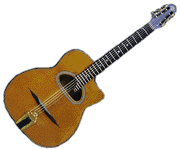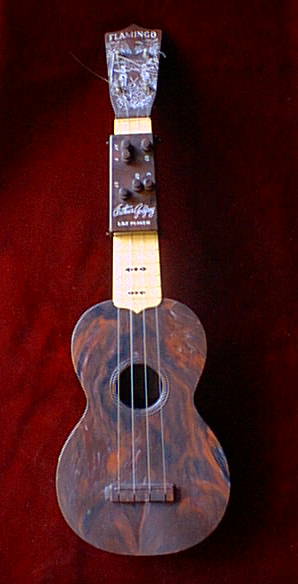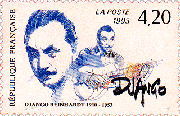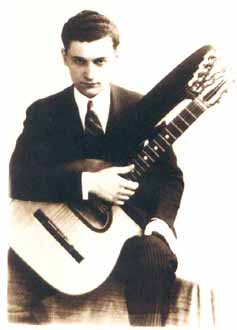
Background
information
the rest of
the site
Email:
click
here
|
Mario Maccaferri's extraordinary life
could
(and, I believe, will) fill a book; here is but a brief glance.
In 1929, Maccaferri settled in London where, amidst his touring schedule, he taught guitar. Ever passionate about lutherie, he dreamt continually of a more ideal, more sonorous guitar. Before long he generated several new prototypes. Presented in London at the dawn of the 1930's, these were the progenitors of his most lasting contribution to lutherie. Upon being shown these latest
creations, the Davis brothers, who managed Selmer's London dealership,
in turn introduced Maccaferri to Henri Selmer himself. With their
assurances
and in consideration of Maccaferri's formidable lutherie background
with
Mozzani, Monsieur Selmer accepted the idea of constructing guitars
within
the Selmer manufacturing facility at Mantes-la-Ville, near Paris. Soon enough, the atelier was begun under Maccaferri's direction. He drew up the plans for the guitars, had molds and jigs made. Numerous workers, for the most part Italians, took part in the building of the shop and received training from Maccaferri in his production techniques. On the sixth of May 1932, patent #736,779 was registered in Paris, entitled "Perfectionnements aux violons, guitars, mandolines et autres instruments à cordes." Its résumé proposed:
musical instruments of an internal resonating box, affixed to the vibrating top of the instrument..." During this brief but revolutionary epoch the first Selmer Maccaferri guitars were produced. Maccaferri supervised the fabrication of each model. Even the cases for the guitars were made there. By 1933, with production completely operational, Mario Maccaferri was increasingly less in evidence at the atelier. It seems there was a dispute with Henri Selmer which led to a peremptory departure from the firm some time late in 1933. Was it a contract problem? The Selmer company remains discreet on this subject to this day. A consummate guitarist, Maccaferri longed to return to touring, to travel and perform once again around Europe. During the summer of 1933, however, a freak swimming accident badly injured his right hand, bringing his concertising career to an end. Yet his life continued. During his time at Selmer, he had discovered and learned the technique of making reeds for saxophones and clarinets. Maccaferri oriented himself from then on with the making of reeds, creating his "French-American Reed Manufacturing Company." In 1935 he filed for a patent for his shaping of reeds. In 1938, he set up a branch of that business in New York, moving there the next year in order to flee the war in France.
 With his plastics business on firm ground, offering clothespins, bathroom tile and a host of other injection-molded products, it wasn't until many years later, in the fifties, that the irrepressible luthier in him surfaced once more. Alas, his Maccaferri plastic guitars, while conceived as a serious musical instrument, were not a market success. Nonetheless, he handily recouped his guitar losses with the famous plastic ukes with the Arthur Godfrey Chord Finder. Through his long and colorful life, Maccaferri's unique brilliance never diminished. At the time of his passing in May of 1993, he was at work perfecting his plastic violins. If Maccaferri spent but little time at Selmer, two short years at best, he remains the creator of an atelier which produced revolutionary and highly prized guitars. Their success was both immediate and enduring. This article is adapted from an article I originally wrote for Guitar Player Magazine. It is different than the French language article written by François Charle. That article is taken, with François Charle's permission, from a wonderful book called Luthiers & Guitares d'en France, written collaboratively by a number of authorities on French guitars, including Francis Cabrel, Muriel Ferstenberg, and Klaus Blasquiz. It documents, in rich photos and text, the work of more than fifty contemporary luthiers in France, and included several historical articles, this being one. It's published by Editions Chandelle, and you may still be able to obtain a copy from R&F Charle. At the moment, the book is only available in French, but the photos are the heart, and they're very fine.
Drop
me
a line
click
here
This page © 1998-2010 Paul Hostetter. All rights reserved. |



 Surmounting
yet another setback, when the primary source of reed making cane from
southern
France was cut off by wartime shipping problems, Maccaferri developed a
viable plastic reed, the Maccaferri Futurity reed. Endorsed by Benny
Goodman
and others, his reedmaking enterprise survived the hazards of wartime
shortages
and propelled him into a thriving business in plastics.
Surmounting
yet another setback, when the primary source of reed making cane from
southern
France was cut off by wartime shipping problems, Maccaferri developed a
viable plastic reed, the Maccaferri Futurity reed. Endorsed by Benny
Goodman
and others, his reedmaking enterprise survived the hazards of wartime
shortages
and propelled him into a thriving business in plastics.
